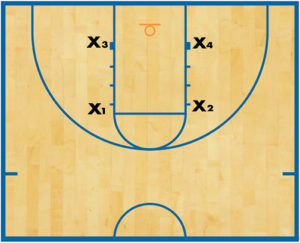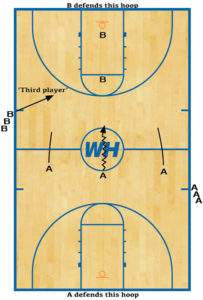Drilling your players to perfect their man defense
Once you know what it takes to install proper man defense within your first six practices of the season, use the following drills to complement that knowledge.
First practice
The keys of man defense to teach at your first practice include stance and position; defense on the ball; and defense off the ball. Here are the drills to use.
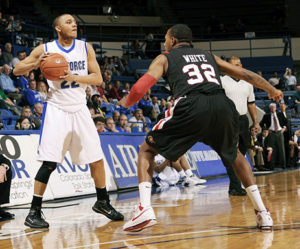 Command Drill. This drill is used to get everyone loose and ready to go. Divide your players into three lines within the width of the court. The coach stands in front of the players with a ball. Issue each of the following eight commands, and the players respond:
Command Drill. This drill is used to get everyone loose and ready to go. Divide your players into three lines within the width of the court. The coach stands in front of the players with a ball. Issue each of the following eight commands, and the players respond:
- Stance. All players go from a standing posture to a defensive posture. They are focused with their heads up. This position is held for a few seconds, which gives you a good idea of who is off-balance. Pay particular attention to players being up on the balls of their feet, backs are straight, and hands are out.
- Fire. All players start pumping their legs in place as a group. Heads are up, arms out, and feet are moving. Keep this going for several seconds.
- Right (or left). On this call, players move two steps in the direction indicated. Players use their hand to “dig up” at the imaginary ball in front of them. They also call out the direction they are moving with each step.
- Retreat. Players move backward using the pivot drop-step move for two steps on this call while keeping low. Eyes remain focused on the coach and their bodies are over their feet. Players must twist their hips and feet, but not their torso.
- Loose ball. Players hit the floor, as if scrambling for a loose ball. Then, as quickly as possible, players get back on their feet and into a defensive posture with feet moving.
- Charge. Players fall back onto the large muscle of their buttocks. They do not flop. They need to be careful of whipping their heads and shoulders into the ground.
- Held ball. Yell “5” and players move a step closer to you as if you are the offensive player. Players trace the ball with their hands. If you pivot away, they move closer.
- Shot. Players rise up and pivot to box out the “shooter.”
Shuffle the lines. All players are aligned on the baseline. On the whistle, the first player assumes a defensive stance and starts using a defensive slide along the outside lines of the court. Players need to stay down with hands out, while digging up with the lead hand. When the first player reaches half-court, the next player goes. Remind players this is not a race, and never to cross their feet.
Zigzag the floor. Create two court-long lanes from the sideline to the foul-lane line and from the foul-lane line to the sideline. Players must stay in their lane. One player uses a ball, and one plays defense. The defender moves with the offensive player as they go down the court. When the defender reaches the sideline, the defender continues out of bounds for a one-third step (to make sure he or she is not passed by the offensive player), and the defender plants the outside foot and pivots on it to change directions. Initially, this is a slow and deliberate drill, as players learn not to hop to change directions.
Shadow. A player is in a defensive stance on the sideline facing the court. Three or four players line up in a row facing the first player. On the whistle, the player in the defensive stance moves back and forth forward and backward. The players lined up opposite and attempt to move with the defender. After 20 seconds, rotate another player to the sideline position.
Stop and go. Use this drill to teach defenders to sprint ahead of the ball to get a stop rather than running with the dribbler. One player has a ball and starts dribbling the length of the court. Another player, the defender, sprints ahead of that player and attempts to force the offensive player to pick up the dribble. Once the dribble is picked up, the defender uses his or her body to remove space and uses hands to trace the ball.
Defensive position (shell). The drill starts with four offensive players spaced around the arc, and four defenders on the baseline. The coach is under the basket with a ball. Pass the ball to one of the offensive players. On the pass, the defenders sprint out to defend. The defender on the ball breaks down the receiver. The other three defenders use proper breakdown techniques to ensure their offensive player does not just drive past them. The player, now with the ball, holds it for a two-count then passes to a teammate. Offensive players only are allowed to pass. Make sure the help defenders are sagging to the paint and recovering on the pass. Eventually, feel free to add that offensive players can shoot off the pass catch.
Shell penetration. The variation to the Shell Drill entails offensive players only scoring off a dribble drive. So the goal of each offensive player is to split two defenders. Defenders must be in a position to help and deny the drive. Let the teams play until either the offense scores or the defense gets a turnover.
Second practice
The keys of man defense to teach at your second practice include jump to the ball; handling cutters; and help and recover.
Jump to the ball. A coach is on the right wing with an offensive player dribbling at the top of the key, with a defender guarding the dribbler. The offensive player passes to the coach. On the pass, the defender takes one quick retreat step toward the pass. The result of this step is that the defender has the left hand and foot up toward the “line of the ball” and the right foot back a bit. The offensive player tries to cut across the face of the defender to receive a return pass.
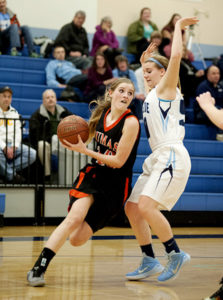 Shell cutter. This drill is just like the Shell Drill, but the offense only uses cuts off the passes. This allows the defense to focus on the “jump to the ball” technique. The coach passes to an offensive player, and the defenders break down the players they are guarding. The ball moves around the perimeter and any offensive player can cut to the basket from any spot on the floor. If the cut is not successful, one of the other offensive players replaces the cutter. Have the defense stay in the original areas as it helps create game-like mismatches.
Shell cutter. This drill is just like the Shell Drill, but the offense only uses cuts off the passes. This allows the defense to focus on the “jump to the ball” technique. The coach passes to an offensive player, and the defenders break down the players they are guarding. The ball moves around the perimeter and any offensive player can cut to the basket from any spot on the floor. If the cut is not successful, one of the other offensive players replaces the cutter. Have the defense stay in the original areas as it helps create game-like mismatches.
Help and recover. Have two players on the wing, and a player at the top of the key with a ball on offense. Place three defenders opposite the offensive players. The player with the ball drives at the defender. If the defender is beaten, the call is “Help!” and the other defensive players drop into a help position as the drive is occurring.
Once the drive is stopped, the offensive player picks up the dribble. Now the call is “5!” like in previous drills, and the defenders go into full denial mode while staying between their offensive player and the ball. The player passes out to a wing the defenders recover, and now the wing drives starting the motion again.
Third practice
The keys of man defense to teach at your third practice include breaking down the shooter; bumping the center; running through the passing lane; and rebounding.
Free-throw, close-out. Have four players line up on the baseline with basketballs, and four players line up opposite of them at the free-throw-extended area. On the whistle, the players on the baseline pass to the players opposite them. Upon receiving the ball, the players assume a triple-threat position. The passers sprint out about halfway then start taking short, choppy steps to break down the shooter. The defender keeps the left hand high to challenge the shot.
Progressive. This drill is used over the course of the next four practices to develop the skills for breaking down the shooter and defending the offensive player. Start with a wing offensive player and a defender in help position in the paint. The coach is stationed on the opposite wing with a ball.
Part 1. The coach throws a skip pass to the offensive player. The defender leaves the help position and charges at the shooter. The defender uses the breakdown technique of small, choppy steps to get to the ball. The offensive player holds the ball in front. The defender touches the ball and the drill ends.
Part 2. The drill starts the same as the previous, except this time the offensive player catches and shoots. The defender executes the same breakdown technique. The defender calls “shot” and boxes out the shooter. Remind the defender that once the shot is in the air, the main responsibility is to deny the rebound to the shooter.
Part 3. This is the same drill, except the offensive player catches and drives. The defender executes the same breakdown technique and stops penetration, or forces a bad shot.
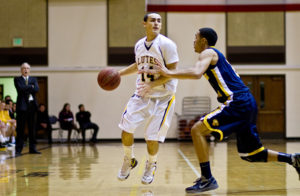
Part 4. The offensive player has the option of shooting or driving. Make a game of this drill. If the shooter catches, shoots and scores, it is worth three points, regardless of the location on the floor. Any basket off a drive is worth two points.
Body/hold/release. Use this drill to “introduce” players to the basic movements of rebounding. Have two lines of players facing each other about two feet apart. One line is the shooters, and one is the defenders. When the coach calls “Body,” the defenders turn into the shooter (either the reverse pivot or a step-across turn). The defender takes a good rebounding stance. When the coach calls “Hold,” the defender focuses on maintaining contact with the shooter using the elbows back buttocks and peripheral vision. When the coach calls “Release,” the rebounder explodes forward and up, driving hands up together catching the rebound.
Shell rebounding. This is set up like the Shell Drill, but have the offensive player take a shot after a skip pass or a couple of passes. The defense must rebound. Have an assistant coach watch for players that boxed out, or did not, and turn that into a competition.
Two-player tip. Have players line up in pairs facing each other, each pair with a ball. Have one person toss the ball to the other. The receiver catches the ball at the height of the jump and returns it to the passer. Do this five times then reverse roles.
Two-line outlet. Have two lines of players start at the elbows facing the basket. Place two managers or players on each wing. Each line has a ball. The players approach the basket and lob the ball off the backboard. They then leap forward, securing the ball at the top of their leap with both hands. Their legs should be spread wide so they have a solid base to land. They must create space before leaping, then leap forward to catch the ball. As they secure the ball, they call “Transition,” which informs the other teammates that they have the ball and to start heading up the floor. Once the ball is secured, the player pivots on the outside foot and passes to the wing. Have the receivers vary their position on the floor so the rebounder has to pivot and change the angle on the pass.
Two-line outlet dribble. This is the same drill as the Two-line outlet, except the rebounder takes a few dribbles toward the wing before passing.
Minnesota rebounding. Start with three offensive players spread around the perimeter. Have three defenders in the lane in a line. Have a coach positioned in the short corner with a ball. Assign the offensive players numbers and tell the defenders their responsibility. The coach passes the ball to a perimeter player, and that player shoots. The defenders must close out and defend against the assigned offensive player. Switch assignments so the defenders have to find a different player.
Three in a row. Place a line of players at the top of the key. Have a single offensive player at the foul line, and a single defender in the lane opposite of the foul-line player. A coach on the wing takes a shot (there is a coach on the other wing as well). The foul-line offensive player battles the defender for the rebound. Once the ball is secured, it is passed to the other manager. The next player in line steps up to the foul line to be defended. Once the defensive player grabs three rebounds in a row, that player gets in line and a new defender takes the court.
Weak-side rebounding. Start with two offensive players on the wings defended by two other players. A coach is at the top of the key with a ball and passes to a wing. The defender on the ball handler takes a solid, defensive containment posture. The weak-side defender drops to a help position. Now, the player shoots and the weak-side defender first, finds their player, then boxes out. The defensive team needs to get three rebounds in a row before coming off the court.
Offensive contact. Start with three players facing the backboard to one side with the player in the middle holding a ball. The ball is tossed off the backboard, the rebound is secured by that player. To secure the ball, the player catches it at the height of the jump with both hands, making sure the ball is above the forehead and elbows out. That player now uses a two-handed power move to score. The other two players use slight contact (or more) to try to force the rebounder to miss, travel or commit a turnover.
Fourth practice
The keys of man defense to teach at your fourth practice include defending the post and tipping from behind.
Post defense. Place a player or coach at the top of the key, the wing and the corner. Position an offensive and defensive player in the post. The ball starts at the top of the key and is rotated to the wing, then the corner. At each stop, check the defensive positioning of the defender. Speed it up and try it from both sides of the floor.
Tip from behind (TFB) No. 1. Start with two lines of players on the baseline to the side of the basket. The line closest to the basket is the offensive line. One player is at half-court. The half-court player, and the first person at the beginning of the outside line, are defenders. The drill starts when the offensive player dribbles slowly to half-court. This is a slow, controlled dribble. The defensive player follows, looking for an opportunity to flick the ball ahead as it’s coming up from the floor. Make sure it’s on the upward movement of the ball, as the momentum of the ball carries farther in this scenario. And the defender needs to use the arm closest to the ball to tip it so as not to reach in. On the tip, the half-court player recovers the ball and becomes an offensive player with the player who tipped the ball. Now the original dribbler becomes the defender in a 2-on-1 situation.
Tip from behind (TFB) No. 2. This drill is the same until the 2-on-1 situation after the tip. On the tip, the player who tipped the ball goes to the corner for a 3-point shot. The defender is instructed only to defend the rebounder so the player in the corner has an open shot.
Tip from behind (TFB) No. 3. Place an additional player at half-court. Once the transition occurs from the original drill to 2-on-1 situation, the extra player sprints back to help on defense, which adds a sense of urgency to the 2-on-1 break and forces the defenders to talk as they adjust to the 2-on-1 situation.
Fifth practice
The defensive concepts to teach at the fifth practice are handling screens and help techniques.
Shell screen. This just like the Shell Drill, only players are allowed to screen defenders. Talk to your players about how you want them to defend screens. Communication must be stressed, no matter if you plan on switching on the screen or not.
Help-side defense. There are two wing players on offense, a defender in the low post on the ball side, and a second defender in a help position on the opposite wing player. Simulate the wing player beating the defender off the dribble. The beaten defender yells “Help!” The low-post player slides over to stop the drive. The opposite wing defender drops into the paint to protect the basket. Once the drive is stopped, the ball is passed to the opposite wing and the drill starts over from the other side.
Sixth practice
The sixth practice is a review of all the concepts stressed in the first five practices. Utilize the drills that your team had trouble with the first time around.


